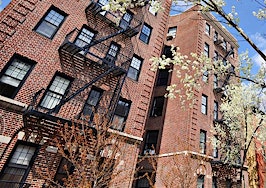- In 2010, San Jose's City Council in 2010 approved an ordinance requiring new residential development projects of 20 or more units to sell at least 15 percent of the for-sale units at a price the city would determine to be "affordable" or pay a $122,000 in-lieu fee.
- The California Building Industry Association (CBIA) filed a lawsuit arguing that the ordinance was invalid.
- The Supreme Court has declined to hear the case -- meaning the ordinance will move forward, developers are still on the hook, and agents in San Jose might see fewer transactions.
If local governments strongarm developers into paying for housing viewed as a public need, will that have unintended consequences for the local market?
That’s the concern of many real estate agents in San Jose.
Last month, the U.S. Supreme Court declined to hear a case concerning a San Jose, California, zoning ordinance aimed at increasing the development of affordable housing in the supply-depleted Bay Area.
Real estate agents in the area are worried that the ordinance could actually discourage developers from pursuing their affordable housing projects, further constricting the housing supply in San Jose and driving home prices up even further.
Bay Area prices causing housing demand pressure
California cities and counties, particularly those located in the Bay Area, have been struggling with high housing demand pressures due to huge job market gains for at least a half a century — and San Jose is definitely no exception.
According to Zillow’s most recent estimates, the median home value in San Jose is $817,000. San Jose home values have gone up 11.1 percent over the past year, and Zillow predicts they will rise 2.1 percent within the next year.

Chuck Reed
“The Bay Area has not met the need for affordable housing for decades because we have restrictive land-use policies that greatly prohibit supply,” said Chuck Reed, who served as San Jose’s mayor from 2007 to 2014. “Cities have no revenue source for affordable housing, yet the demand is still there. So many counties and municipalities went looking for creative ways to get revenue for affordable housing.”
Desperate times call for creative measures
Seeking a way to address the lack of sufficient affordable housing units, nearly 200 California municipalities have adopted “inclusionary zoning” programs, which the U.S. Department of Housing and Urban Development (HUD) has defined as housing programs that “require or encourage developers to set aside a certain percentage of housing units in new or rehabilitated projects for low- and moderate-income residents.”
“This integration of affordable units into market-rate projects creates opportunities for households with diverse socioeconomic backgrounds to live in the same developments and have access to [the] same types of community services and amenities,” HUD stated in a 2013 publication, Inclusionary Zoning and Mixed-Income Communities.
With many housing industry analysts and economists bemoaning a shortage of affordable housing for both owners and renters in many markets across the country, such efforts may seem laudable.

Rick Smith
But Rick Smith, who has worked as a licensed real estate broker in the area for 30 years and is currently broker and owner of Windermere Silicon Valley in Santa Clara, pointed out that “affordable housing” in San Jose has a completely different meaning from affordable housing in a market like Detroit.
“What people in other cities call affordable housing, we call condos,” said Smith, who is president-elect of the Santa Clara County Association of Realtors and a director for the California Association of Realtors.
“Just because they are considered below market-rate properties, that doesn’t change the homes’ values. These are brand-new homes with beautiful landscaping. Other than a few upgrades that these buyers may not opt to pay extra for, there is no difference in these properties than the ones next door.”
And when it comes to the income levels of these needy buyers, San Jose is unique as well, Smith said.
“The higher our prices go, the lower the percentage of the population that can actually afford an average-priced house. I have seen people with high-paying tech jobs who make over a quarter of a million dollars choose to move out of the area because they can’t afford to buy here,” he said.
San Jose’s solution
When San Jose city officials began to take a closer look at its affordable housing crisis, the city determined that it needed about 19,000 low-income housing units in order to meet the needs of its community.
When a study determined that San Jose’s existing low-income housing inventory wouldn’t meet that demand, the City Council in 2010 approved an inclusionary zoning ordinance requiring all new residential development projects of 20 or more units to sell at least 15 percent of the for-sale units at a price the city would determine to be affordable for qualified low- to moderate-income buyers, or pay a $122,000 in-lieu fee.
These units would be subject to long-term recorded encumbrances ensuring that the homes themselves remain part of the city’s stock of affordable housing for 45 years for for-sale homes and 55 years for rental homes.
“There is tremendous demand for affordable housing, but no one wants to pay for it. Inclusionary zoning is a way for cities to make someone else pay for it,” said Reed, who has since moved on to become special counsel for Hopkins & Carley, a law firm serving Silicon Valley businesses and individuals.
The lawsuit
San Jose’s ordinance was scheduled to take effect on Jan. 1, 2013, but the California Building Industry Association (CBIA), a Sacramento-based advocacy organization for the housing and the building industries, had other ideas.
Shortly after the ordinance was enacted, the CBIA filed a lawsuit in Santa Clara County Superior Court, arguing that the ordinance was invalid on its face because the city failed to provide enough evidence of a relationship between the ordinance’s requirements for developers to provide affordable housing and the impact of the development.
The court agreed, and it issued an injunction enjoining the city from enforcing the ordinance.
On appeal to the 6th District Court of Appeal, that injunction was overturned; the ordinance was held to be valid and the case was remanded to the Superior Court to render a decision consistent with the appellate court’s decision.
Not to be deterred, the CBIA appealed the decision further to the California Supreme Court, which in June 2015 affirmed the Court of Appeals’ decision upholding the ordinance and remanded the case to trial court.
“The ordinance created this construct that developers can avoid having restrictions placed on their properties if they pay money to buy their way out of it,” said Reed. “That is not a tax or extraction, it’s a use of police power. And when you read through the California Supreme Court’s opinion, there are very few limits on the use of that police power.”
This, the CBIA argued, raised an issue concerning the limitations that the Takings Clause of the Fifth Amendment of the U.S. Constitution places on a government’s authority to use the permit process to force private property owners to dedicate private property for a public use — and last fall, the association asked the Supreme Court to address this question.
But on Feb. 29, the High Court denied the CBIA’s petition because it had technical legal problems that may have prevented it from addressing the CBIA’s question.
The Supreme Court’s decision not to hear a case is not a comment on the case’s merits; it merely means that a majority of the justices have determined that the circumstances described in the plaintiff’s position are insufficient to warrant the court’s review.
Unintended consequences
However, the court did seem to recognize the uncertainty its decision may cause, as in a brief concurring opinion, Justice Clarence Thomas said the San Jose case presented “compelling reasons for resolving this conflict at the earliest practicable opportunity.”
“Until we decide this issue, property owners and local governments are left uncertain about what legal standard governs legislative ordinances and whether cities can legislatively impose exactions that would not pass muster if done administratively,” Thomas wrote.
In a statement, Brian Hodges, attorney for the Pacific Legal Foundation, a conservative Sacramento group that represented the CBIA, said he was disappointed in the Supreme Court’s decision not to hear the case.
“The rights of all property owners were dealt a blow today, as San Jose’s punitive treatment of homebuilders was allowed to stand,” Hodges said.
The CBIA did not respond to requests for comment on this story.
But Sam Liccardo, San Jose’s current mayor, had a statement of his own: “The Supreme Court ruling could not have come any sooner for the thousands of families in our community who are struggling to keep up with skyrocketing rents, and we look forward to implementing this policy as quickly as possible,” he said.
Former mayor Reed said he fears the court’s inaction may open the door for all local governments, “which are always short on money and looking to find revenue somewhere, to use that police power.”
“The message here for land owners and developers is that the U.S. Constitution will not protect you from that,” Reed said.
What happens next?
With the debate unresolved for now, San Jose’s ordinance will move forward, and Reed said he is concerned that some developers will consider dropping their projects if they can no longer negotiate land prices or meet the costs of the ordinance’s requirements.
“Projects that may be in the planning process and haven’t yet gotten permits or entitlements will have to comply with this and redo their numbers,” Reed said. “This means the developer will either have to give up its profits, or the land owner will have to take a haircut. Land owners who don’t want to take a haircut will be willing to wait for the market to reach a point where they can get asking price for their land. The supply of new units will be reduced.”
And that may mean fewer transactions for real estate agents and brokers. Smith said he is concerned the zoning ordinance will actually raise the price of properties in San Jose.
“The real estate industry as a whole is definitely against this type of thing, and we have fought against it by lobbying to our local, county and state officials to the best of our ability because we don’t think it’s in the best interest of the population,” Smith said.
“Sometimes government puts in laws based on a chronic point in time that have lasting, forever effects. Sometimes they believe that circumstances have gotten so far out of whack that a law is required to repair it, but I think that is a short-sighted way of doing it.
“In real estate, things run in cycles. But the law doesn’t.”









